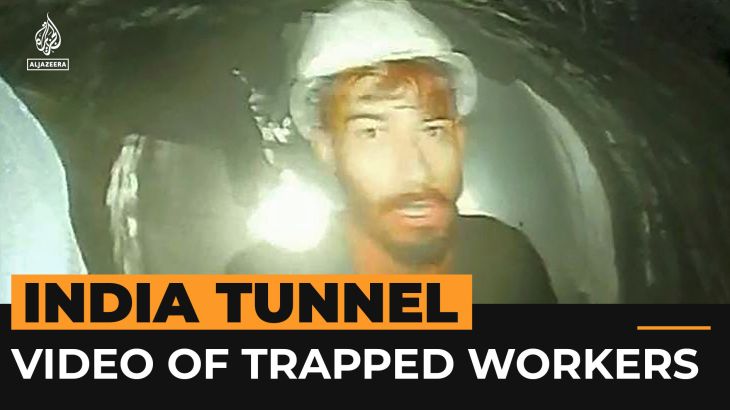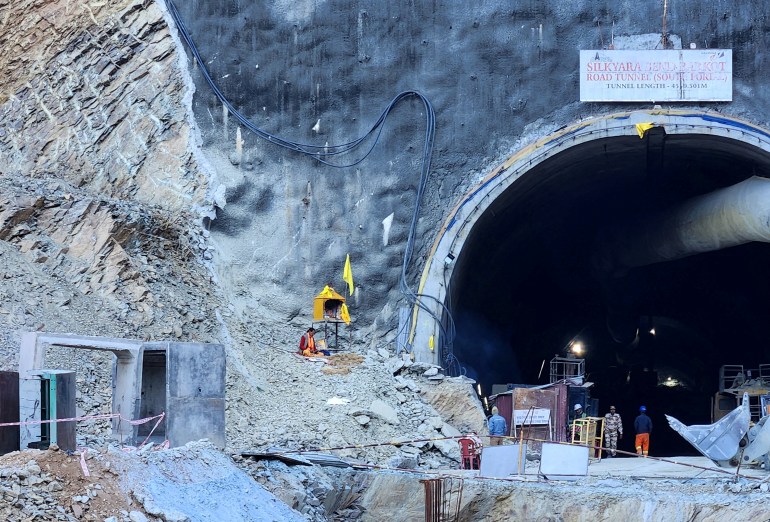Indian workers trapped in Himalayan tunnel for 10 days seen on camera
The 41 workers inside a collapsed road tunnel have been seen alive for the first time amid attempts to create new passageways to free them.

The first images of 41 men trapped for 10 days in a highway tunnel in the Indian Himalayas have emerged, showing them standing in a confined space and communicating with rescue workers.
A 30-second video provided by authorities on Tuesday showed about a dozen of the trapped men standing in a semi-circle in front of the endoscopic camera, wearing helmets and construction worker jackets over their clothes against the backdrop of the lights in the tunnel.
Keep reading
list of 4 itemsRescuers to dig new shaft for 41 workers trapped in India tunnel for 9 days
India pauses efforts to rescue workers trapped in tunnel over cave-in fears
Indian rescue teams say all 40 workers in tunnel collapse found safe
The men looked exhausted and anxious, some with thick beards, while a rescue worker outside could be heard telling them to present themselves one by one to confirm their identities on the walkie-talkie gear that had been sent in.
“We will bring you out safely, do not worry,” rescuers can be heard telling the men as they gather near the camera.
The video was shot through a medical endoscopy camera that was pushed through a second, wider pipeline of 15cm (6 inches) in diameter, drilled through the debris on Monday, authorities said.
Before the camera was introduced, rescuers had been communicating with the men inside using radios.
‘Take care of yourselves’
The 41 men have been stuck in the 4.5km (3-mile) tunnel in Uttarakhand state since it caved in early on November 12 and are safe, authorities said, with access to light, oxygen, food, water and medicines.
They have not said what caused the cave-in, but the region is prone to landslides, earthquakes and floods. Efforts to bring out the workers have been slowed by snags in drilling through the debris in the mountainous terrain.

Rescuers are set on Tuesday to resume drilling horizontally through a 60-metre (195-ft) pile of debris to push through a pipe large enough for the trapped men to crawl out.
Drilling had been suspended on Friday after a machine snag and fears of a fresh collapse.
Authorities are simultaneously working on five other plans to pull out the workers, including drilling vertically from the top of the mountain.
Abhishek Sharma, a psychiatrist sent to the site by the state government, said he had asked the 41 men to walk within the 2km (1.2-mile) area where they are confined, do light yoga exercises and talk regularly among themselves to keep occupied.
“Sleep is very important for them … and as of now they have been sleeping well and not reported any difficulties in sleeping,” Sharma told Reuters, adding that the men were in good spirits and keen to emerge soon.
Another doctor at the site, Prem Pokhriyal, said the men had been asked to avoid heavy workouts that could boost the accumulation of carbon dioxide gas in the confined space as they breathe out.
The trapped men are low-wage workers, most of them from poor states in India’s north and east.
“He said he is doing fine,” Sunita Hembrom, the sister-in-law of one of the workers trapped in the tunnel, Surendra Kisko, told reporters after she spoke to him.
“He said, ‘Take care of yourselves, the children and parents. Just tell us what they are doing to get us out of here.'”
Experts have warned about the effects of extensive construction in Uttarakhand, where large parts of the state are prone to landslides.
The planned tunnel is part of Prime Minister Narendra Modi’s infrastructure plans aimed at cutting travel times between some of the most popular Hindu sites in the country, as well as improving access to strategic areas bordering rival China.
Foreign experts have been drafted in, including Australian independent disaster investigator Arnold Dix, president of the International Tunnelling and Underground Space Association.
“Those 41 men are coming home,” Dix told the Press Trust of India news agency. “Exactly when? Not sure.”